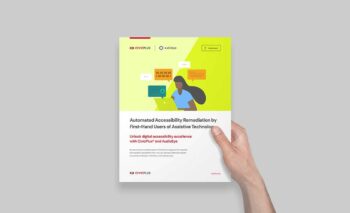The Intersection of AI and Accessibility: Opportunities, Challenges, and Best Practices
Local governments are tasked with delivering essential services and resources while creating positive experiences for residents. Interactions with community members occur every day, and artificial intelligence (AI) is transforming how government agencies address common challenges to improve engagement and service delivery.
Over the last several years, the need for more efficient and cost-effective solutions has driven higher adoption of AI technology in the public sector. A critical area of consideration for government agencies looking to implement or expand AI usage is digital accessibility. With nearly 30% of U.S. adults living with a disability, government websites and other digital spaces need to be accessible to all.
From chatbots to predictive analytics, AI can help agencies make information and services easily accessible online. In this piece, we explore the responsible use of AI to enhance accessibility features for government websites and digital services to better service disabled people. To use AI responsibly in this way, it’s important to first understand the unique opportunities and challenges.
AI Brings New Opportunities to Make Digital Spaces More Accessible
Local governments need to overhaul existing infrastructures, and AI is emerging as an effective way to do that. AI solutions present prime opportunities to enhance assistive technologies online for all residents including people with disabilities.
Here are some examples of how this is happening:
- Voice-Activated Assistance: Voice recognition technology makes it possible for residents with visual or physical impairments to navigate digital spaces they otherwise couldn’t.
- Personalized User Experiences: Web content can be adjusted to fit each resident’s unique needs. For instance, AI can be implemented to adjust font sizes and page layouts to improve navigability and readability. Automated closed captioning creates written captions for audio and video materials, making it more accessible for those who are deaf or hard of hearing.
- AI-Driven Chat Features: AI solutions, like chatbots and automated customer service platforms, boost community satisfaction rates. Chat features that use AI to respond to inquiries in real time enhance user engagement by reducing response times for common questions and offering immediate, accessible support. The City of Toronto saw a 40% increase in service requests that were handled online after implementing an AI-driven solution.
- Predictive Accessibility Solutions: Predictive analytics help agencies uncover where potential barriers exist in any of the digital services and experiences they offer. Local governments can then proactively address challenges like navigational difficulties to maintain accessibility.
- Text-to-Speech Capabilities: AI technology converts written text and content into spoken language for residents with reading disabilities, visual impairments, or communication challenges, allowing them to engage with their local government. For example, Cboard helps children and adults with speech and language impairments communicate through symbols and text-to-speech functionality.
- Real-time Translations: Machine learning-based language models help government websites automatically translate content into multiple languages. By removing language barriers, all residents are empowered to access the government services to which they are entitled.
These AI advancements are bridging the digital divide so that any resident, regardless of their level of ability, can easily engage and interact with the government services they need.
5 Challenges to Consider When Leveraging AI Technology for Digital Accessibility
While the opportunities for improving accessibility with AI are growing, its use comes with inherent challenges that must be properly addressed. This list covers the five most common challenges and what agencies can do to overcome them.
1. Risk of AI Bias
AI programs can be predisposed to biases, often present in the data used to train systems. As a result, certain groups or individuals may be inadvertently excluded or put at a disadvantage.
Reducing algorithmic bias requires consistent and thorough analysis as well as the implementation of more diverse training sets and human intelligence.
2. Complexity of Implementation
Integrating AI solutions can be both technically and financially challenging, especially for small or under-resourced communities. Meeting accessibility requirements (e.g., WCAG criteria) may necessitate additional resources or expertise, which isn’t always available. To maximize resources and maintain accessibility standards, partner with service providers that offer comprehensive AI solutions and support for staff training.
3. Security and Data Privacy Concerns
Accessibility software like real-time personalization, text-to-speech, and automated closed captioning typically rely on the collection of sensitive user information. Transparency and trust are crucial for agencies, so striking a balance between improvements with AI and strong privacy protection is a top concern. Ongoing regulatory oversight is a must, and agencies should use software with robust privacy and compliance features to stay ahead.
4. Lack of Guidelines, Guardrails, and Standardization
While WCAG and other accessibility standards exist, they may not always align with emerging AI technologies. This can lead to disparities in how AI systems are built, affecting whether they are universally accessible. To avoid inconsistencies in how accessibility features are implemented or understood requires continual review of regulatory guides and standards, plus solutions designed to address broader ranges of capability.
5. Gaps in Digital Literacy
When using AI applications and solutions, there’s often an assumed baseline level of digital literacy, which excludes many users. For example, voice-activated systems may be difficult for those unfamiliar with giving voice commands to operate. User education and ongoing support are must-haves to ensure residents can access the capabilities they need.
Best Practices for Using AI Responsibly
Communicate How AI is Used and What Data is Collected
To maintain public trust and regulatory compliance, clearly explain AI processes in simple and accessible language. This can be anything from publishing policies on AI usage to providing disclosures on how algorithms are integrated to support chatbots and personalization. Use transparent, open communication to reassure residents that they are top-of-mind when it comes to AI decision-making processes.
Audit and Monitor AI Systems
Government websites must be periodically assessed for effectiveness, fairness, and accessibility compliance. Setting consistent timelines for these audits helps identify algorithmic issues that may affect how users access digital services, keeping systems aligned with changing regulations.
Implement Bias-Free Design
Regularly testing AI applications is key to uncovering potential inaccessibility and unintended bias. Local governments should always include diverse user groups from the community when conducting AI testing, as it helps uncover and address biases that may be present in training data.
AI-Driven Accessibility Enhances Government Websites
Communities are increasingly diverse and regulatory compliance for the public sector continues to expand. As local governments strive to improve online services to individuals with disabilities to meet these changes and requirements, AI integrations are paving a new path for digital accessibility.
Local governments must make sure digital content is easy for residents with disabilities to access and use. Tech options that support this, like AI applications, need to be efficient, affordable, and simple to implement and deploy. Not to mention compliant with all laws, regulations, and mandates.
To find out more about how to use AI thoughtfully and responsibly, explore solutions that keep accessibility issues and inclusivity as a core value.


